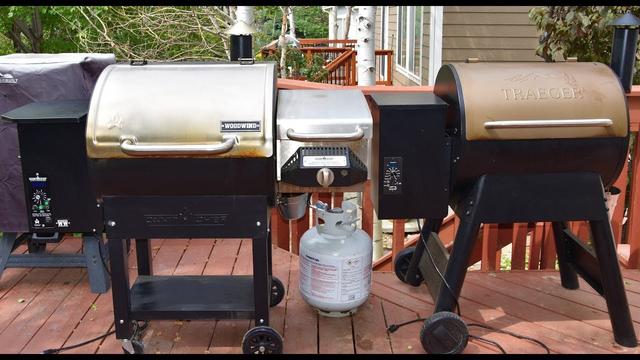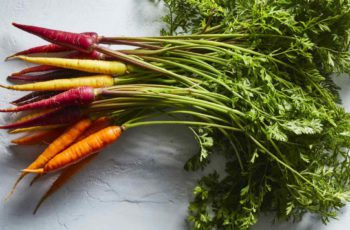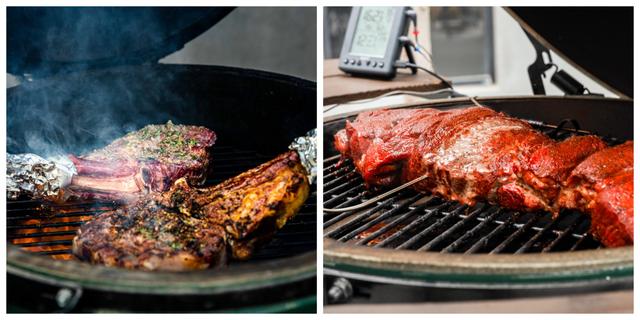
“BBQ vs Grilling: Unraveling the Sizzling Debate! Discover the key differences between these popular cooking techniques and get ready to ignite your taste buds. From slow-smoked flavors to quick seared perfection, delve into the world of BBQ and grilling to elevate your outdoor cooking game.”
What’s BBQ?
BBQ, short for barbecue, refers to a cooking method that involves slow-cooking meat at low temperatures for an extended period of time with wood smoke. It is all about producing tender and smoky-tasting meat. Traditional BBQ typically requires cooking at temperatures between 225°-275°F (107°-135°C) for several hours or even up to 14 hours for certain cuts of meat like brisket. Some popular cuts of meat used in BBQ include beef brisket, pork butts, and ribs. These large cuts of meat are cooked slowly to break down the tough fibers and render out fat, resulting in tender and flavorful meat.
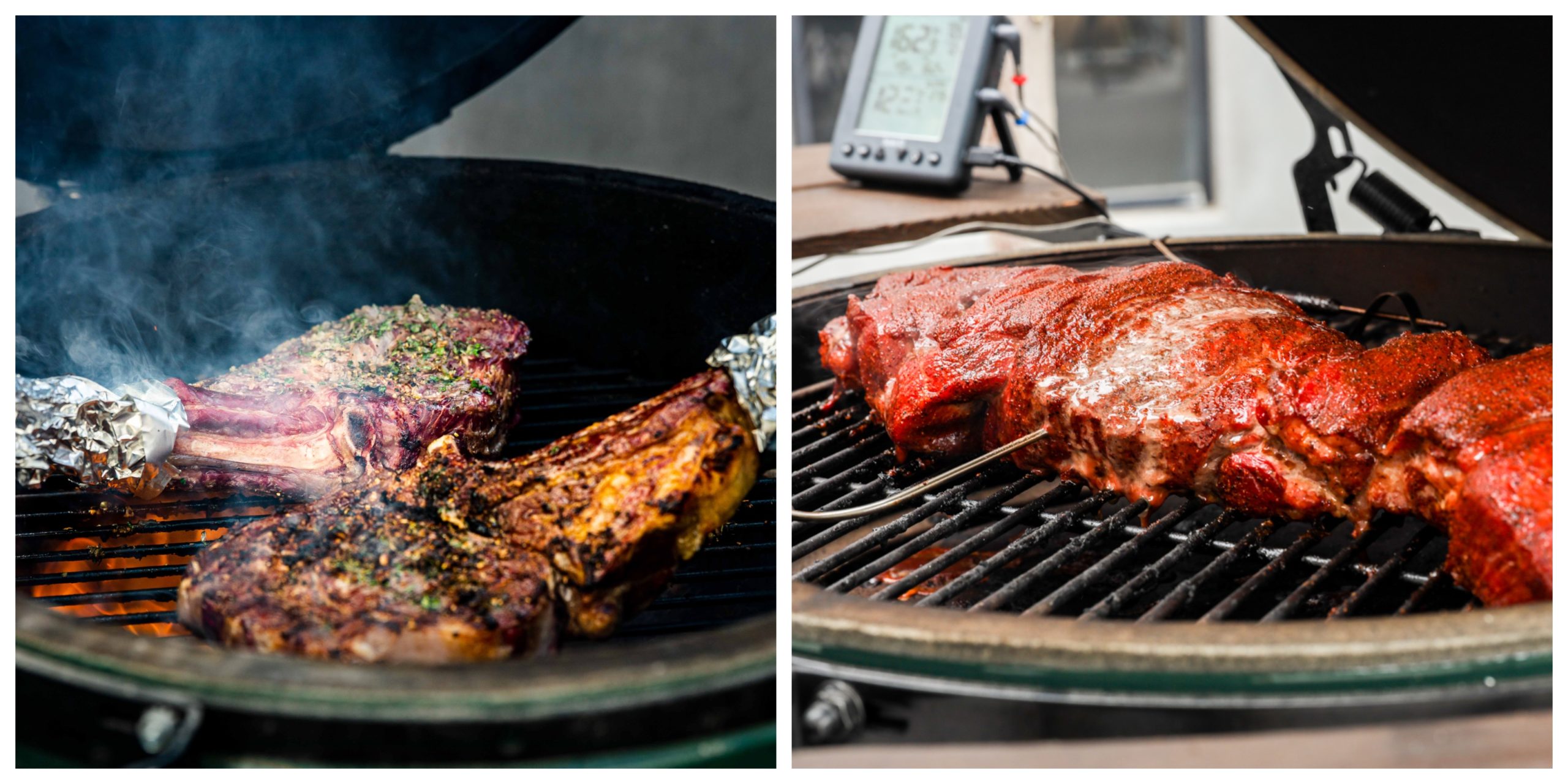
Grilling, on the other hand, involves cooking food quickly over high heat using a gas or charcoal grill. It is not limited to just meat but can include fruits and vegetables as well. Grilling temperatures can range from 350°F (177°C) up to 700°F (370°C), depending on what you’re cooking. Unlike BBQ, grilling is best suited for smaller cuts of already tender meat that can be cooked to desired internal temperatures relatively quickly. Steaks, burgers, pork chops, and poultry are commonly grilled.
In terms of the equipment used, BBQ is often associated with smokers which are designed for low-and-slow smoking of food. Smokers provide indirect heat by circulating smoke and heat from a firebox into the main cooking chamber where the food is placed. On the other hand, grills are designed to deliver direct heat directly to the surface of the food being cooked. Gas grills have visible burners while charcoal grills allow you to see burning charcoal easily.
When it comes to necessary tools, both BBQ and grilling require gloves for heat protection, good quality tongs for handling food, a grill spatula for flipping, and a grill brush for cleaning the grates. An instant-read thermometer is essential for checking temperatures while cooking. For BBQ, investing in a leave-in thermometer can be helpful for monitoring temperatures throughout the long cooking process.
Cultural Differences On The Word Barbecue
Depending on where you’re from, the term ‘barbecue’ can have different meanings. In the northern parts of the United States, it is commonly used to refer to a summer cookout where food is prepared on a gas or charcoal grill with no wood smoke or long cooking times involved. In Australia, Canada, and other countries, they refer to gas and charcoal grills as barbecues. However, for those who are well-versed in low-and-slow cooking with wood, barbecue will always mean food that’s wood smoked at low temperatures for a long time.
In terms of cultural differences within the larger wood-smoked barbecue community, some areas like Texas are beef-heavy while others like North Carolina focus more on pork. Different regions also have their own distinct types of barbecue sauce. Despite these variations, they all agree that barbecue involves low temperatures, wood smoke, and a long cooking time spent at the pit.
Why Do Some People Call AGrillABarbecue?
Some people may call a grill a barbecue because the terms are used interchangeably in certain regions or cultures. For example, in Australia and Canada, the word “barbecue” is often used to refer to gas or charcoal grills. In these cases, the focus is on cooking food quickly over high heat. However, for those who are familiar with traditional barbecue, it means low-and-slow cooking with wood smoke for a long time. The term “barbecue” is associated with tender and smoky-tasting meat that has been cooked at low temperatures for an extended period of time.
There are also cultural differences within the barbecue community that contribute to the variations in the use of terms and preferences for different types of meat and sauces. Different regions have their own specialties, such as Texas being known for beef-heavy barbecue while North Carolina focuses on pork and different types of sauce. Despite these differences, all forms of barbecue generally involve slow cooking with wood smoke and low temperatures.
In contrast, grilling typically involves using a gas or charcoal grill to cook food quickly over high heat. Grilling can be done with various types of meat as well as fruits and vegetables. It is characterized by shorter cooking times compared to barbecue, with food usually coming off the grill within 30 minutes. While some practices from barbecue can still be applied to grilling, such as using dry rubs or adding sauce to chicken or pork, there are certain considerations when grilling at higher temperatures to prevent burning or overcooking.
The equipment used for barbecue differs from that used for grilling. Barbecue typically requires a smoker, which is designed for low-and-slow smoking of food. Smokers can have various designs but generally involve delivering low temperatures and indirect heat to cook the meat slowly while infusing it with smoky flavor. On the other hand, grills are designed to provide direct heat at high temperatures directly onto the surface of the food. While some grills can be used for smoking with indirect heat, they are primarily designed for direct-heat grilling.
In terms of necessary tools, gloves to protect hands from heat, quality tongs and spatula for handling food, a grill brush for cleaning the grates, and an instant-read thermometer are essential for both grilling and smoking. For smoking, it is also recommended to invest in a leave-in thermometer to monitor temperatures throughout the long cooking process.
What IsGrilling?

Grilling is a cooking method that involves using a gas or charcoal grill and cooking food quickly over high heat. It is a popular method for cooking various types of food, including meats, fruits, and vegetables. The temperature range for grilling can vary between 350°F (177°C) to upwards of 700°F (370°C), depending on the type of food being cooked.
When grilling, it is important to be mindful of the ingredients used in preparation. Dry rubs can still be applied to enhance the flavor of the food, but ingredients that are prone to burning at higher temperatures should be avoided. Barbecue sauces can also be added to grilled chicken or pork, but it is best to add them late in the grilling process to prevent burning and bitterness.
When To UseBBQRubs AndSaucesWhenGrilling
When grilling, it’s common to use BBQ rubs and sauces to enhance the flavor of the food. BBQ rubs are a mixture of spices and herbs that are applied to the surface of the meat before cooking. They add depth and complexity to the flavor profile and can help create a delicious crust on the meat. Rubs are especially useful when grilling larger cuts of meat like brisket or pork butt.
BBQ sauces, on the other hand, are typically used as a finishing touch during grilling. They can be brushed onto the meat towards the end of cooking to add a sweet, tangy, or spicy flavor. It’s important to apply sauce late in the grilling process so that sugars in the sauce don’t burn and turn bitter. The sauce should be allowed to set and even caramelize slightly before removing the food from the grill.
What Kinds Of Meat Are Better Suited To BBQ vs Grilling?
When it comes to choosing the right meat for BBQ or grilling, there are certain cuts that are better suited for each cooking method. For BBQ, which involves slow cooking at low temperatures with wood smoke, large and tough cuts of meat like beef brisket, pork butts, and ribs are ideal. These cuts need a long cooking time to break down the tough fibers and render out the fat, resulting in tender and flavorful meat.
On the other hand, grilling is best suited for smaller and more tender cuts of meat that can be cooked quickly over high heat. Steaks, burgers, pork chops, and poultry are great options for grilling. The goal of grilling is to achieve a beautiful char on the outside while keeping the inside juicy and cooked to your preferred doneness.
What’s The Difference Between ABarbecueAnd AGrill?
The main difference between a barbecue and a grill lies in the cooking method and the type of heat used. Barbecue involves low and slow cooking at temperatures between 225°F-275°F (107°C-135°C) with wood smoke for an extended period of time. This results in tender, smoky-tasting meat. On the other hand, grilling is done quickly over high heat, usually on a gas or charcoal grill, with temperatures ranging from 350°F-700°F (177°C-370°C). Grilling produces juicy meat with a beautiful char.
Barbecue is well-suited for big, thick cuts of meat that need to break down slowly to become tender. This includes beef brisket, pork butts, ribs (pork or beef), and pork belly. These cuts have plenty of intramuscular fat that renders out during the cooking process, adding flavor and keeping the meat juicy. Smoking can also be used for whole chickens and turkey.
Grilling, on the other hand, is best suited for smaller cuts of meat that are already tender or can be cooked quickly. This includes steaks, beef burgers, pork chops and loins, and poultry. It’s important to cook these cuts to their recommended internal temperatures for optimal safety and taste.
To enhance your barbecue or grilling experience, there are a few essential accessories you’ll want to have:
- Gloves: Protect your hands from the heat of the smoker or grill.
- Tongs: Get a pair of good quality tongs that can withstand high heat for flipping and handling food.
- Grill spatula: Use a sturdy spatula specifically designed for grilling to flip your food with ease.
- Grill brush: Keep your grill grates clean with a grill brush to prevent sticking and ensure proper heat distribution.
- Instant-read thermometer: A must-have tool for checking the internal temperature of your meat, regardless of whether you’re smoking or grilling.
- Leave-in thermometer (for smoking): Invest in a quality leave-in thermometer to monitor temperatures throughout the long cooking process when smoking meat.
(Note: This response is an abridged version due to character limitations)
BBQ
Traditional barbecue involves cooking meat at low temperatures for an extended period of time with wood smoke. It results in tender, smoky-tasting meat. Barbecue is about slow cooking with wood smoke to produce flavorful and juicy cuts of meat. It typically includes beef brisket, pork butts, and ribs.
Barbecue requires low temperatures between 225°-275°F (107°-135°C) and can take hours or even up to 14 hours for certain cuts of meat. The meat is often prepared with dry rubs and can be injected with liquids like stock or apple juice for added flavor and moisture. Different regions have their own preferences for sauce and cooking methods, but the core principle of barbecue remains slow cooking with wood smoke.
Grill
In terms of grilling, it involves using a gas or charcoal grill with high heat to cook food quickly. Grilling can be done with various types of meat, fruits, and vegetables. The temperature for grilling can range from 350°F to upwards of 700°F, depending on what you are cooking. Grilling is typically a quick cooking method, with food coming off the grill within 30 minutes.
When grilling, it is important to be mindful of the ingredients used for preparation. Dry rubs can still be applied to the food, but care must be taken as sugar and other ingredients may burn at higher temperatures. Barbecue sauces can be added during the grilling process, but it is best to do so towards the end to prevent burning and bitterness.
Cuts of meat that are well-suited for grilling are typically smaller cuts that are already tender. Steaks, beef burgers, pork chops, and poultry are commonly grilled to desired internal temperatures. The internal temperature for poultry should reach 165°F while pork can be grilled to 145°F.
PelletGrills
Pellet grills are a type of grill that use wood pellets as the fuel source. These grills have a hopper where you load the pellets, and an auger system that feeds the pellets into a fire pot. The fire pot then ignites the pellets, creating heat and smoke for cooking. Pellet grills offer the convenience of set-it-and-forget-it cooking, as they can maintain consistent temperatures with the help of digital controls. They also allow for a wide range of cooking temperatures, making them versatile for both low-and-slow smoking and high-heat grilling.
What Accessories Do I Actually need For BBQ Smoking or Grilling?
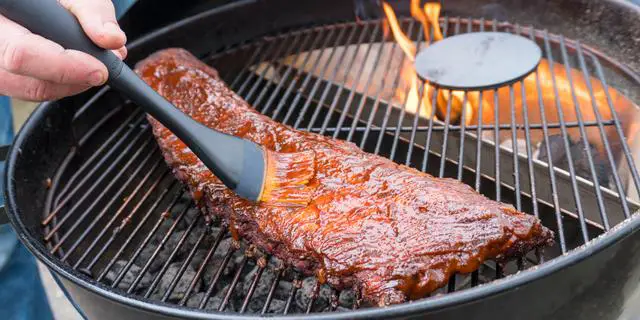
When it comes to BBQ smoking or grilling, there are a few essential accessories that you will need to ensure a successful cooking experience. First and foremost, you will want to invest in a good pair of heat-resistant gloves to protect your hands from the intense heat of the smoker or grill. These gloves will not only keep you safe but also allow you to handle hot items with ease.
In addition to gloves, having a set of high-quality tongs is crucial for flipping and maneuvering food on the grill. Look for tongs that are sturdy and have a good grip, as they will be your go-to tool for handling meat, vegetables, and other grilled items.
A grill spatula is another must-have accessory for both grilling and BBQ smoking. This tool is perfect for flipping burgers, steaks, and delicate fish fillets without damaging them. Look for a spatula with a long handle to keep your hands away from the heat.
To maintain cleanliness and prevent food from sticking to the grill grates, a grill brush is essential. This tool allows you to easily scrape off any residue or burnt bits from previous cookouts, ensuring that your food cooks evenly and doesn’t stick.
Lastly, investing in an instant-read thermometer is highly recommended for both grilling and BBQ smoking. This tool allows you to accurately measure the internal temperature of your meat, ensuring that it is cooked to perfection every time. For longer smoking sessions, consider purchasing a leave-in thermometer that can monitor the temperature throughout the cooking process.
Wrapping It Up
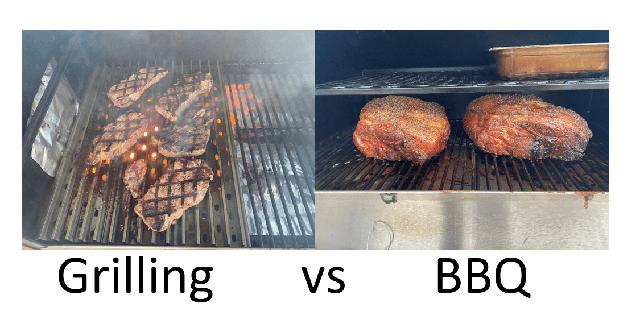
In conclusion, the main difference between BBQ and grilling lies in the cooking methods and the desired outcome. BBQ involves slow cooking at low temperatures with wood smoke to produce tender and flavorful meat, while grilling involves high heat and quick cooking for a charred and juicy result. The choice of meat for BBQ is typically large cuts like beef brisket, pork butts, and ribs, while grilling is suitable for smaller cuts that are already tender.
When it comes to equipment, smokers are used for BBQ as they provide indirect heat and allow for the infusion of wood smoke flavors. On the other hand, gas and charcoal grills are designed for direct heat grilling. While you can attempt to smoke on a grill, it won’t yield the same results as using a dedicated smoker.
To ensure successful BBQ or grilling sessions, it’s important to have essential tools such as gloves, tongs, spatula, grill brush, instant-read thermometer, and leave-in thermometer for monitoring temperatures during long smoking sessions. With these tools and an understanding of the differences between BBQ and grilling, you’ll be well-equipped to enjoy deliciously cooked meats.
FAQS:
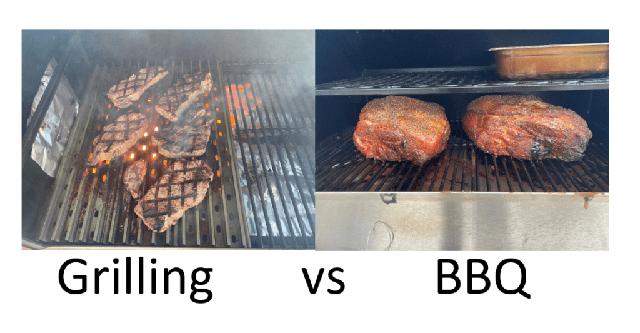
1. What is the difference between BBQ and grilling?
The main difference between BBQ and grilling is the cooking method and temperatures used. BBQ involves slow cooking at low temperatures (around 225°-275°F or 107°-135°C) with wood smoke, resulting in tender, smoky-flavored meat. Grilling, on the other hand, is done quickly at high temperatures (ranging from 350°F to upwards of 700°F or 177°C to 370°C), typically on a gas or charcoal grill.
2. What kinds of meat are better suited to BBQ vs grilling?
BBQ is well-suited for big, thick cuts of meat that need to break down slowly to become tender. This includes beef brisket, pork butts and shoulders, pork belly, chuck roasts, and ribs. These cuts have plenty of intramuscular fat that renders out during the slow cooking process, keeping the meat juicy. Grilling, on the other hand, is better suited for smaller cuts of meat that are already tender enough. Steaks, burgers, pork chops, loins, and poultry can be grilled to perfection.
3. What accessories do I need for BBQ smoking or grilling?
When it comes to accessories for BBQ smoking or grilling, there are a few essentials you’ll want to have. These include heat-resistant gloves to protect your hands from the heat of the smoker or grill, good quality tongs for handling food on the grill, a grill spatula for flipping food, a grill brush for cleaning your grill grates, an instant-read thermometer for checking temperatures while cooking, and possibly a leave-in thermometer if you’re doing long smoking sessions.
Question: Why Do You Spray Meat WhenSmoking?
When smoking meat, it is common practice to spray the meat with a liquid during the cooking process. The main reason for spraying meat when smoking is to help keep it moist. Smoking is a slow and indirect cooking method that can dry out the meat if not properly monitored and maintained. By spraying the meat with a liquid, such as water, apple juice, or vinegar, you are adding moisture back into the meat and preventing it from becoming dry.
Another reason for spraying meat when smoking is to enhance the flavor. Many people choose to spray their meat with a mixture of liquids and spices or herbs to add additional flavors to the surface of the meat. This can create a more complex and delicious taste.
Additionally, spraying can help create a beautiful bark on the outside of the meat. The liquid helps to dissolve some of the seasoning rub on the surface of the meat, allowing it to form a crust or bark that adds texture and flavor.
Overall, spraying meat when smoking is an important step in maintaining moisture, enhancing flavor, and creating an appealing appearance for your smoked meats.
Question: Is it spelledbarbequeorbarbecue?
The correct spelling is “barbecue.” The word “barbecue” refers to the cooking method of slow-cooking meat over low temperatures with wood smoke. The term “barbeque” is often used as a variant spelling, but the preferred and more commonly accepted spelling is “barbecue.”
Question: IsBBQan American thing?
BBQ, or barbecue, is often associated with American cuisine and is deeply rooted in American culture. However, the concept of cooking meat low and slow over a fire has been practiced in various forms throughout history and across different cultures. While the techniques and flavors may differ, many countries around the world have their own versions of barbecue. For example, countries like Argentina are known for their traditional method of grilling large cuts of beef over an open flame. In Australia, barbecues are a popular social activity where people gather to cook meat and other foods on gas or charcoal grills. So while BBQ has strong ties to American culture, it is not exclusive to the United States.
In conclusion, while BBQ and grilling are often used interchangeably, they are distinct cooking methods. BBQ involves slow cooking over low heat with smoke for enhanced flavor, while grilling is a quicker process over direct heat. Both techniques offer unique tastes and experiences, catering to different preferences and occasions. Whether you prefer the smoky tenderness of BBQ or the charred intensity of grilled food, both options provide delicious results for outdoor cooking enthusiasts.
Learn More About Grilling
If you want to learn more about grilling, check out these other helpful resources!

